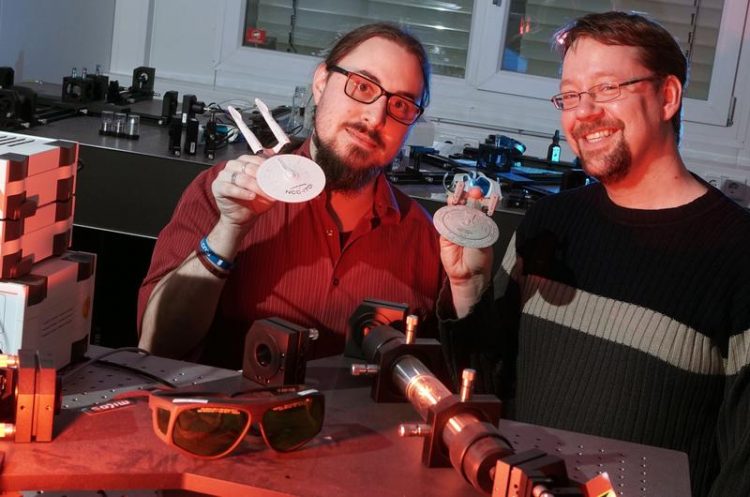Star Trek’s Vision Becomes Reality

Juniorprof. Dr Alexander Szameit (r.) and Dr Marco Ornigotti with models of the USS Enterprise. The physicists (University of Jena) for the first time demonstrate teleportation of classic objects. Photo: Jan-Peter Kasper/FSU
„Beam me up, Scotty“ – even if Captain Kirk supposedly never said this exact phrase, it remains a popular catch-phrase to this day. Whenever the chief commander of the television series starship USS Enterprise (NCC-1701) wanted to go back to his control centre, this command was enough to take him back to the control centre instantly – travelling through the infinity of outer space without any loss of time.
But is all of this science fiction that was thought up in the 1960s? Not quite: Physicists are actually capable of beaming—or „teleporting“ as it is called in technical language – if not actual solid particles at least their properties.
“Many of the ideas from Star Trek that back then appeared to be revolutionary have become reality,” explains Prof. Dr Alexander Szameit from the University of Jena (Germany). “Doors that open automatically, video telephony or flip phones – all things we have first seen on the starship USS Enterprise,” exemplifies the Juniorprofessor of Diamond-/Carbon-Based Optical Systems. So why not also teleporting?
“Elementary particles such as electrons and light particles exist per se in a spatially delocalized state,” says Szameit. For these particles, it is with a certain probability thus possible to be in different places at the same time. “Within such a system spread across multiple locations, it is possible to transmit information from one location to another without any loss of time.” This process is called quantum teleportation and has been known for several years.
The team of scientists lead by science fiction fan Szameit has now for the first demonstrated in an experiment that the concept of teleportation does not only persist in the world of quantum particles, but also in our classical world. Szameit and his colleagues report about these achievements in the scientific journal “Laser & Photonics Reviews” (DOI: 10.1002/lpor.201500252).
They used a special form of laser beams in the experiment. “As can be done with the physical states of elementary particles, the properties of light beams can also be entangled,” explains Dr Marco Ornigotti, a member of Prof. Szameit’s team. For physicists, “entanglement” means a sort of codification. “You link the information you would like to transmit to a particular property of the light,” clarifies Ornigotti who led the experiments for the study that was now presented.
In their particular case, the physicists have encoded some information in a particular polarisation direction of the laser light and have transmitted this information to the shape of the laser beam using teleportation. “With this form of teleportation, we can, however, not bridge any given distance,” admits Szameit. “On the contrary, classic teleportation only works locally.” But just like it did at the starship USS Enterprise or in quantum teleportation, the information is transmitted fully and instantly, without any loss of time. And this makes this kind of information transmission a highly interesting option in telecommunication for instance, underlines Szameit.
Original publication:
Diego Guzman-Silva et al. Demonstration of local teleportation using classical entanglement, Laser Photonics Rev. 2016, DOI 10.1002/lpor.201500252
Contact:
Juniorprof. Dr Alexander Szameit, Dr Marco Ornigotti
Institute of Applied Physics at the University of Jena
Albert-Einstein-Straße 15, 07745 Jena
Germany
Phone: +49 (0) 3641 / 947985, +49 (0) 3641 / 947990
E-mail: alexander.szameit[at]uni-jena.de, marco.ornigotti[at]uni-jena.de
Media Contact
All latest news from the category: Physics and Astronomy
This area deals with the fundamental laws and building blocks of nature and how they interact, the properties and the behavior of matter, and research into space and time and their structures.
innovations-report provides in-depth reports and articles on subjects such as astrophysics, laser technologies, nuclear, quantum, particle and solid-state physics, nanotechnologies, planetary research and findings (Mars, Venus) and developments related to the Hubble Telescope.
Newest articles

Uranium-immobilizing bacteria in clay rock
Microbial reduction reduces mobility of uranium compounds. When designing repositories for high-level radioactive waste in deep geological layers, various factors must be carefully considered to ensure their long-term safety. Among…

6G mobile communications tested in the Alps
Researchers at the University of Stuttgart achieve strongest connection. Making emergency calls even in remote areas and transmitting large amounts of data in real time? This is possible with the…

Optimising inventory management
Crateflow enables accurate AI-based demand forecasts. A key challenge for companies is to control overstock and understock while developing a supply chain that is resilient to disruptions. To address this,…





















